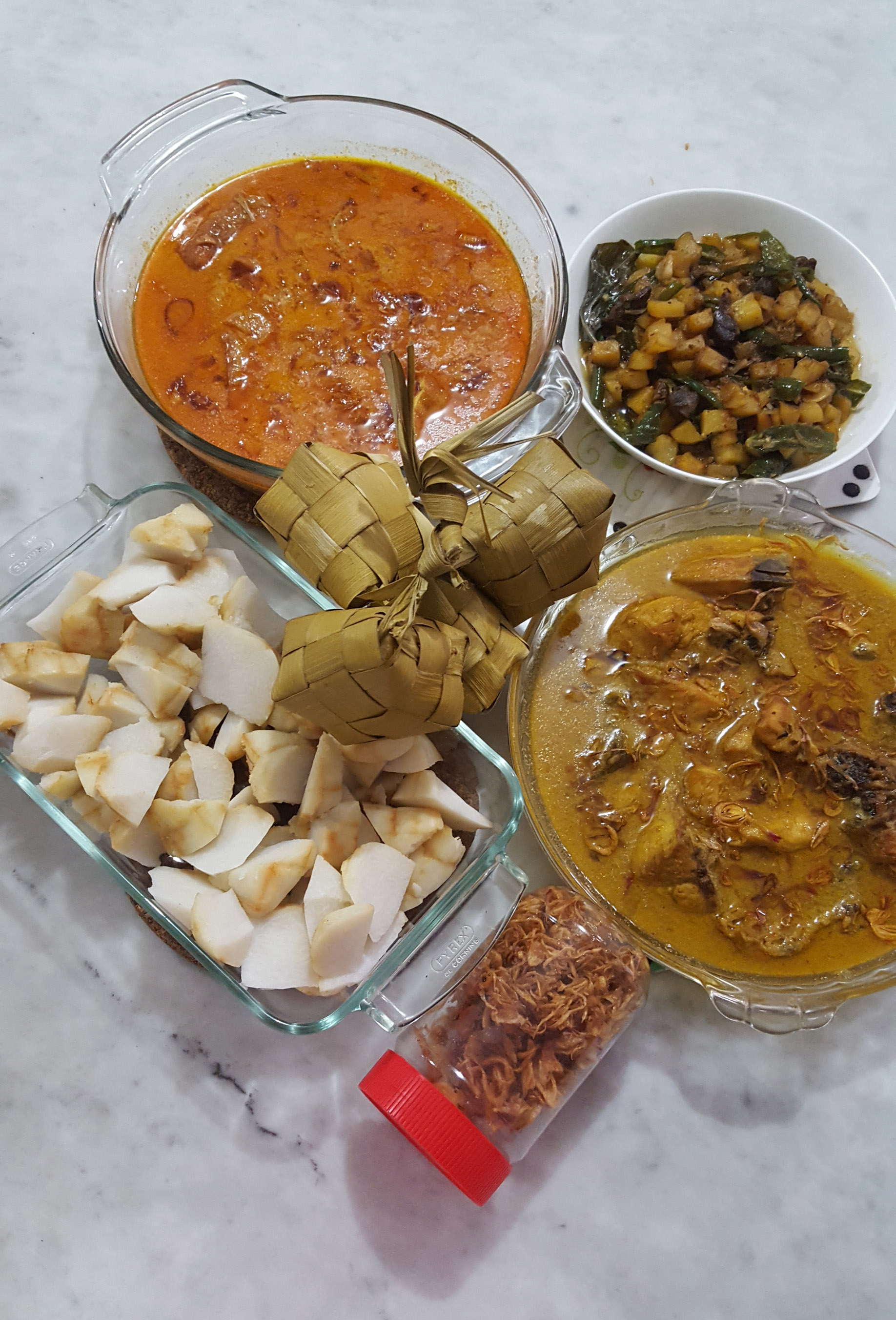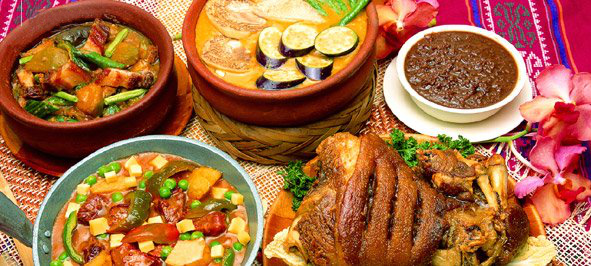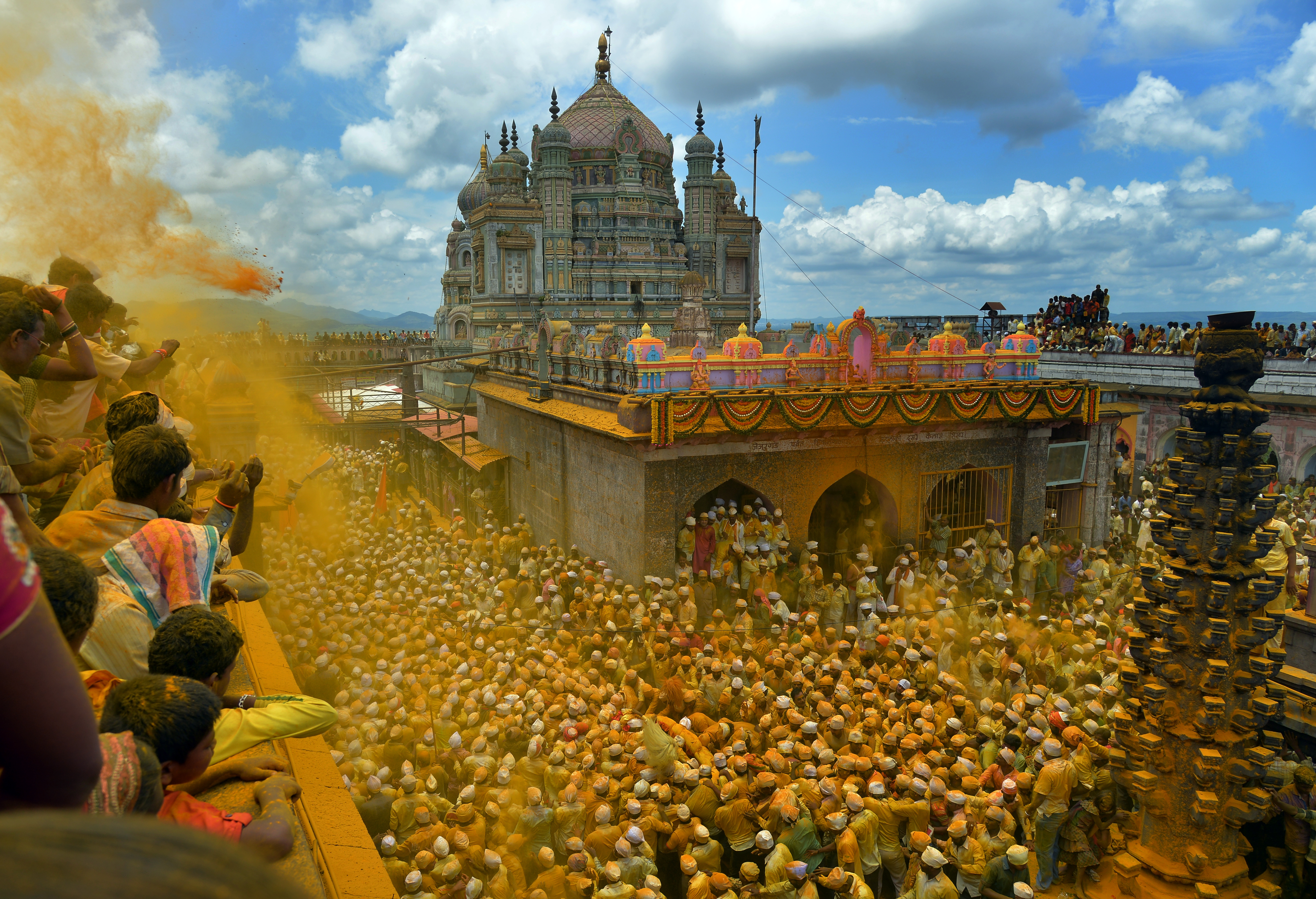|
Rendang
Rendang is a fried meat or dry curry made of meat stewed in coconut milk and spices, widely popular across Brunei, Indonesia, Malaysia, Singapore, and the Philippines, where each version is considered local cuisine. It refers to both a cooking method of frying and the dish cooked in that way. The process involves slowly cooking meat in spiced coconut milk in an uncovered pot or pan until the oil separates, allowing the dish to fry in its own sauce, coating the meat in a rich, flavorful glaze. Rooted in Malay and Minangkabau, rendang developed at the cultural crossroads of the Malacca Strait. The dish carries strong Indian influences, as many of its key ingredients are staples in Indian cooking. The introduction of chili peppers by the Portuguese through the Columbian exchange after the capture of Malacca in 1511, played a key role in the evolution of rendang. Malay and Minangkabau traders frequently carried rendang as provisions, allowing the dish to travel naturally through c ... [...More Info...] [...Related Items...] OR: [Wikipedia] [Google] [Baidu] |
Indonesian Cuisine
Indonesian cuisine is a collection of various regional culinary traditions by various ethnic groups that formed in the archipelagic nation of Indonesia. There are a wide variety of recipes and cuisines in part because Indonesia is composed of approximately 6,000 populated List of islands of Indonesia, islands of the total 17,508 in the world's largest archipelago,"Indonesian Cuisine." . Accessed July 2011. Tradition and characteristics Indonesia has around 5,350 traditional recipes, with 30 of them ...[...More Info...] [...Related Items...] OR: [Wikipedia] [Google] [Baidu] |
Malay Cuisine
Malay cuisine (; Jawi script, Jawi: ) is the traditional food of the ethnic Malays of Southeast Asia, residing in modern-day Malaysia, Indonesia (parts of Sumatra and Kalimantan), Singapore, Brunei, Southern Thailand and the Philippines (mostly southern) as well as Cocos (Keeling) Islands, Cocos Islands, Christmas Island, Sri Lanka and South Africa. The main characteristic of traditional Malay cuisine is the generous use of spices. Coconut milk is also important in giving Malay dishes their rich, creamy character. The other foundation is ''belacan'' (prawn paste), which is used as a base for , a rich sauce or condiment made from , chili pepper, chilli peppers, onions and garlic. Malay cooking also makes plentiful use of lemongrass and galangal. Nearly every Malay meal is served with rice, which is also the staple food in many other Asian cultures. Although there are various types of dishes in a Malay meal, all are served at once, not in courses. A typical meal consists of a ... [...More Info...] [...Related Items...] OR: [Wikipedia] [Google] [Baidu] |
Minangkabau Cuisine
Padang cuisine or Minangkabau cuisine is the cuisine of the Minangkabau people of West Sumatra, Indonesia. It is among the most popular cuisines in Maritime Southeast Asia. It is known across Indonesia as ''masakan Padang'' after Padang, the capital city of Western Sumatra province. It is served in restaurants mostly owned by ''perantauan'' (migrating) Minangkabau people in Indonesian cities. Padang food is ubiquitous in Indonesian cities and is popular in neighboring Malaysia, Philippines, Brunei, and Singapore. Padang food is famous for its use of coconut milk and spicy chili. Minang cuisine consists of three main elements: ''gulai'' (curry), ''lado'' (chili pepper) and ''bareh'' (rice). Among the cooking traditions in Indonesian cuisine, Minangkabau cuisine and most of Sumatran cuisine are influenced by Indian and Middle Eastern cuisine, with dishes cooked in curry sauce with coconut milk and a wide variety of spice mixes. Because most Minangkabau people are Muslims, Minan ... [...More Info...] [...Related Items...] OR: [Wikipedia] [Google] [Baidu] |
Malaysian Cuisine
Malaysian cuisine (Malay language, Malay: ''Masakan Malaysia''; Jawi script, Jawi: ) consists of cooking traditions and practices found in Malaysia, and reflects the multi-ethnic makeup of its population. The vast majority of Malaysia's population can roughly be divided among three major ethnic groups: Ethnic Malays, Malays, Chinese Malaysian, Chinese and Indian Malaysian, Indians. The remainder consists of the Dayak people, indigenous peoples of Sabah and Sarawak in East Malaysia, the Orang Asli of Peninsular Malaysia, the Peranakan and Eurasian creole communities, as well as a significant number of foreign workers and expatriates. As a result of historical migrations, colonisation by foreign powers, and its geographical position within its wider home region, Malaysia's culinary style in the present day is primarily a melange of traditions from its Malay, Chinese, Indian, Indonesian cuisine, Indonesian, Thai, Filipino cuisine, Filipino and indigenous Bornean and Orang Asli, w ... [...More Info...] [...Related Items...] OR: [Wikipedia] [Google] [Baidu] |
Kalio
Kalio ( Jawi: كالياو) is an Indonesian type of rendang that is cooked for a shorter period of time and much of the coconut milk liquid has not evaporated. Kalio has quite abundant liquid sauce acquired from cooked coconut milk that partly has turned into spicy oil, which is quite flavourful if consumed with steamed rice. Much of rendang served abroad are actually more akin to kalio or wet version of rendang. If stored at room temperature, kalio lasts less than a week. Kalio usually has a light golden brown colour, paler than dry rendang. See also *Indonesian cuisine Indonesian cuisine is a collection of various regional culinary traditions by various ethnic groups that formed in the archipelagic nation of Indonesia. There are a wide variety of recipes and cuisines in part because Indonesia is composed ... * Minangkabau cuisine References {{Dutch cuisine Indonesian cuisine Padang cuisine Indonesian beef dishes Foods containing coconut ... [...More Info...] [...Related Items...] OR: [Wikipedia] [Google] [Baidu] |
Indonesia
Indonesia, officially the Republic of Indonesia, is a country in Southeast Asia and Oceania, between the Indian Ocean, Indian and Pacific Ocean, Pacific oceans. Comprising over List of islands of Indonesia, 17,000 islands, including Sumatra, Java, Sulawesi, and parts of Borneo and New Guinea, Indonesia is the world's largest archipelagic state and the List of countries and dependencies by area, 14th-largest country by area, at . With over 280 million people, Indonesia is the world's List of countries and dependencies by population, fourth-most-populous country and the most populous Islam by country, Muslim-majority country. Java, the world's List of islands by population, most populous island, is home to more than half of the country's population. Indonesia operates as a Presidential system, presidential republic with an elected People's Consultative Assembly, legislature and consists of Provinces of Indonesia, 38 provinces, nine of which have Autonomous administrative divisi ... [...More Info...] [...Related Items...] OR: [Wikipedia] [Google] [Baidu] |
Filipino Cuisine
Filipino cuisine is composed of the cuisines of more than a hundred distinct Ethnic groups in the Philippines, ethnolinguistic groups found throughout the Philippines, Philippine archipelago. A majority of mainstream Filipino dishes that comprise Filipino cuisine are from the food traditions of various ethnolinguistic groups and tribes of the archipelago, including the Ilocano people, Ilocano, Pangasinan people, Pangasinan, Kapampangan people, Kapampangan, Tagalog people, Tagalog, Bicolano people, Bicolano, Visayan, Chavacano, and Maranao people, Maranao ethnolinguistic groups. The dishes associated with these groups evolved over the centuries from a largely indigenous (largely Austronesian peoples, Austronesian) base shared with maritime Southeast Asia with varied influences from Chinese cuisine, Chinese, Spanish cuisine, Spanish, and American cuisine, American cuisines, in line with the major waves of influence that had enriched the cultures of the archipelago, and adapted us ... [...More Info...] [...Related Items...] OR: [Wikipedia] [Google] [Baidu] |
Coconut Milk
Coconut milk is a plant milk extracted from the grated pulp of mature coconuts. The opacity and rich taste of the milky-white liquid are due to its high oil content, most of which is saturated fat. Coconut milk is a traditional food ingredient used in Southeast Asia, Oceania, South Asia, and East Africa. It is also used for cooking in the Caribbean, Central America, northern parts of South America and West Africa, where coconuts were introduced during the colonial era. Coconut milk is differentiated into subtypes based on fat content. They can be generalized into coconut cream (or thick coconut milk) with the highest amount of fat; coconut milk (or thin coconut milk) with a maximum of around 20% fat; and coconut skim milk with negligible amounts of fat. This terminology is not always followed in commercial coconut milk sold in Western countries. Coconut milk can also be used to produce milk substitutes (differentiated as "coconut milk beverages"). These products are not ... [...More Info...] [...Related Items...] OR: [Wikipedia] [Google] [Baidu] |
Padang
Padang () is the Capital city, capital and largest city of the Indonesian Provinces of Indonesia, province of West Sumatra. It had a population of 833,562 at the 2010 CensusBiro Pusat Statistik, Jakarta, 2011. and 909,040 at the 2020 Census;Badan Pusat Statistik, Jakarta, 2021. the official estimate as at mid 2023 was 942,938 - comprising 473,089 males and 469,849 females.Badan Pusat Statistik, Jakarta, 28 February 2024, ''Kota Padang Dalam Angka 2024'' (Katalog-BPS 1102001.1371) It is the List of cities in Indonesia by population, 16th most populous city in Indonesia and the most populous city on the west coast of Sumatra. The Padang metropolitan area is the List of metropolitan areas in Indonesia, third most populous metropolitan area in Sumatra with a population of over 1.7 million. Padang is widely known for its Minangkabau people, Minangkabau culture, Padang cuisine, cuisine, and sunset beaches. The city had historically been a trading center since the pre-colonial era, in ... [...More Info...] [...Related Items...] OR: [Wikipedia] [Google] [Baidu] |
Jawi Script
Jawi (; ; ; ) is a writing system used for writing several languages of Southeast Asia, such as Acehnese, Banjarese, Betawi, Magindanao, Malay, Mëranaw, Minangkabau, Tausūg, Ternate and many other languages in Southeast Asia. Jawi is based on the Arabic script, consisting of all 31 original Arabic letters, six letters constructed to fit phonemes native to Malay, and one additional phoneme used in foreign loanwords, but not found in Classical Arabic, which are ''ca'' ( ), ''nga'' ( ), ''pa'' ( ), ''ga'' ( ), ''va'' ( ), and ''nya'' ( ). Jawi was developed during the advent of Islam in Maritime Southeast Asia, supplanting the earlier Brahmic scripts used during Hindu-Buddhist era. The oldest evidence of Jawi writing can be found on the 14th century Terengganu Inscription Stone, a text in Classical Malay that contains a mixture of Malay, Sanskrit and Arabic vocabularies. However, the script may have used as early as the 9th century, when Peureulak Sultanate has ... [...More Info...] [...Related Items...] OR: [Wikipedia] [Google] [Baidu] |
Minangkabau People
Minangkabau people (; ; ) are an Austronesian people, Austronesian ethnic group native to the Minangkabau Highlands of West Sumatra, Western Sumatra region on the Indonesian island of Sumatra. The Minangkabau's West Sumatera homelands was the seat of the Pagaruyung Kingdom, believed by early historians to have been the cradle of the Malay race, and the location of the Padri War (1821 to 1837). Minangkabau are the ethnic majority in West Sumatra and Negeri Sembilan. Minangkabau are also a recognised minority in other parts of Indonesia as well as Malaysia, Singapore, and the Netherlands. Etymology There are several possible etymologies for the term Minangkabau (Minangkabau language, Minangkabau: ''Minang'' Jawi script: منڠ). While the word "kabau" undisputedly translates to "buffalo", the word "minang" is traditionally known as the ''pinang'' fruit (areca nut) chewed with ''sirih'' (betel) leaves. But there is also a folklore that mention that term ''Minangkabau'' came f ... [...More Info...] [...Related Items...] OR: [Wikipedia] [Google] [Baidu] |
Turmeric
Turmeric (), or ''Curcuma longa'' (), is a flowering plant in the ginger family Zingiberaceae. It is a perennial, rhizomatous, herbaceous plant native to the Indian subcontinent and Southeast Asia that requires temperatures between and high annual rainfall to thrive. Plants are gathered each year for their rhizomes, some for propagation in the following season and some for consumption or dyeing. The rhizomes can be used fresh, but they are often boiled in water and dried, after which they are ground into a deep orange-yellow shelf-stable spice powder commonly used as a coloring and flavoring agent in many Asian cuisines, especially for curries ( curry powder). Turmeric powder has a warm, bitter, black pepper-like flavor and earthy, mustard-like aroma. Although long used in Ayurvedic medicine, there is no high-quality clinical evidence that consuming turmeric or the principal turmeric constituent, curcumin, is effective for treating any disease. Curcumin, a bright ye ... [...More Info...] [...Related Items...] OR: [Wikipedia] [Google] [Baidu] |







